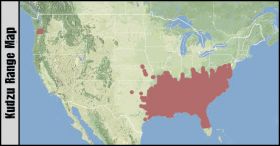Kudzu
Pueraria lobata
This plant is a coarse-growing perennial with trifoliate leaves that have coarsely lobed leaflets. It produces large, wisteria-like, purple flowers on long racemes and beans in flat, papery pods covered with a tawny down. Kudzu plants produce long lateral runners that generate roots at intervals. Being a member of the bean family (Fabaceae), bacteria in the roots fixes atmospheric nitrogen, thus increasing soil fertility wherever it grows
History
Kudzu was introduced into the US at the Philadelphia Centennial Exposition in 1876 and spread during the Great Depression of the 1930’s when the US Government paid farmers $8.00 an acre to plant the stuff on fallow fields and bare banks as a means of controlling erosion.
In its native lands, the roots are used to make a medicinal tea for treating dysentery and fever. In Japan, a kind of kudzu tofu is highly prized. The stems yield a fiber called ko-kemp that is useful in making cloth and paper. And, last but not least, the plant contains a chemical compound, daidzin, that has proven to be effective in suppressing the craving for alcohol.
Related Topics
This plant is a coarse-growing perennial with trifoliate leaves that have coarsely lobed leaflets. It produces large, wisteria-like, purple flowers on long racemes and beans in flat, papery pods covered with a tawny down. Kudzu plants produce long lateral runners that generate roots at intervals. Being a member of the bean family (Fabaceae), bacteria in the roots fixes atmospheric nitrogen, thus increasing soil fertility wherever it grows
History
Kudzu was introduced into the US at the Philadelphia Centennial Exposition in 1876 and spread during the Great Depression of the 1930’s when the US Government paid farmers $8.00 an acre to plant the stuff on fallow fields and bare banks as a means of controlling erosion.
In its native lands, the roots are used to make a medicinal tea for treating dysentery and fever. In Japan, a kind of kudzu tofu is highly prized. The stems yield a fiber called ko-kemp that is useful in making cloth and paper. And, last but not least, the plant contains a chemical compound, daidzin, that has proven to be effective in suppressing the craving for alcohol.

































































































